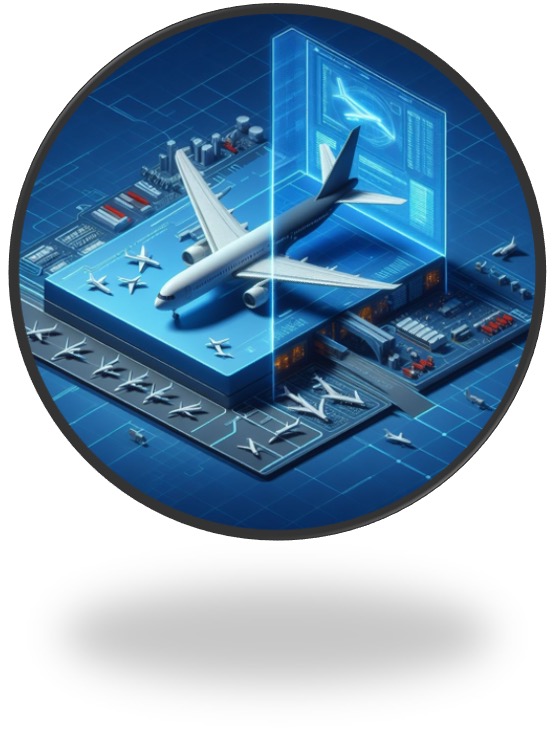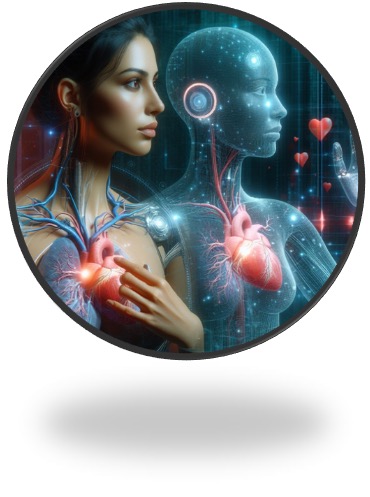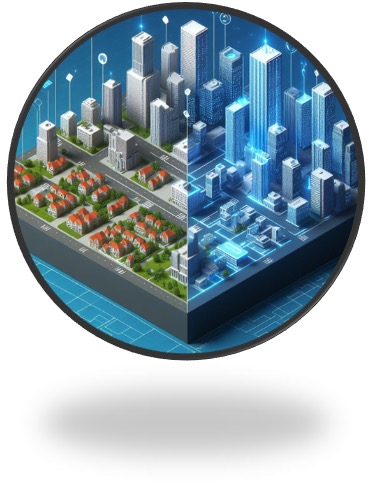This page contains information about the concept of Digital Twin, how it can be used by different industries, and what it means for the future of technology. It also provides supplementary information in the form of websites, videos, and books.
What is a Digital Twin?
Multiple definitions exist, but all of them agree in describing a Digital Twin as a virtual or digital replica of a physical phenomenon.
“A digital twin is a virtual representation of an object or system designed to reflect a physical object accurately. It spans the object’s lifecycle, is updated from real-time data and uses simulation, machine learning and reasoning to help make decisions.” (IBM)
“A digital twin is a high-fidelity, data-driven representation of a real-world system, which can be used to support decision-making.” (Alan Turing Institute)
Some collateral definitions of Digital Twins also exist, but they seem to be specific to certain industries or companies. For example, a digital shadow is an evolving digital representation that mirrors the current state and behaviour of a physical entity or system. A digital model, on the other hand, is a static representation that reflects the physical object’s attributes at a specific point in time but does not update in real-time.
The core idea of using a digital twin to study a physical object was first pioneered by NASA. They envisioned the use of digital twin technology during space exploration missions in the 1960s, when each voyaging spacecraft was exactly replicated in an earthbound version used for study and simulation purposes by NASA personnel. One of the first books to envision the idea of Digital Twins was “Mirror Worlds or The Day Software Puts the Universe in a Shoebox… How it Will Happen and What it Will Mean” (1993). Although its author is a controversial figure, the book is considered an interesting and resourceful read.
In practical terms, Digital Twins can be considered as a combination of existing technologies. These include computational models (simulations), artificial intelligence, sensors, and cloud computing, which can be used altogether and dynamically to form the Digital Twin technology.
“Digital twin technology is still very much in its nascence, but it is growing in momentum, especially in the UK. More than being ‘a technology’, connected digital twins are a means of integrating technologies to achieve a defined purpose – making better decisions faster. It’s this integration of technologies in the service of ‘information flow’ that holds the promise: from the use of sensor technology, 5G and IoT to get data from the physical world into digital twins…to immersive visualisation tools such as AR/VR/MR to facilitate human/digital twin interaction.” (Mark Enzer, OBE, CTO of Mott MacDonald and Head of the National Digital Twin Programme at the Centre for Digital Built Britain)
If you want to read more about Digital Twins in general, here are some interesting blogs and online resources:
- A Digital Twin Might Just Save Your Life
- IBM IoT Cheat Sheet: Digital Twin
- Everything You Need to Know About Digital Twins
- Exploring the concepts of digital twin, digital shadow and digital model
- How will crises affect food systems? Ask a ‘digital twin’
This technology can be applied to multiple domains of application and multiple public and industrial sectors, from healthcare to manufacturing. Learn more about each of them below!
HEALTHCARE
Digital Twins can serve as virtual counterparts to human bodies, allowing healthcare professionals to monitor, analyse, simulate, and optimise health. They can predict medical conditions, personalise interventions, and provide real-time physiological monitoring. With computational resources and clinical data, digital twins enable virtual clinical trials, accelerating therapy development.
Currently, healthcare digital twins dynamically integrate data from EHRs, disease registries, various “-omics” data (like genomics, proteomics, metabolomics, and much more), physical indicators, demographic information, and lifestyle data.
Types of digital twins (DT) in healthcare include:
- Patient-specific DT: These mirror individual patients’ anatomy, genetics, and medical history for personalized treatment, surgical simulations, and drug dosage optimization.
- Virtual Surgical Planning: Detailed 3D models of patients’ anatomies help surgeons plan complex surgeries, anticipate challenges, and improve outcomes.
- Medical Device Design and Testing: Simulate and test medical devices like pacemakers and prosthetics to identify flaws and ensure safety.
- Healthcare Process Optimization: Model healthcare processes to identify inefficiencies, reduce wait times, and improve operational performance.
- Population Health Management: Represent patient groups to analyse trends, predict outbreaks, and tailor interventions.
- Training and Education: Provide realistic simulations for medical training, enhancing clinical skills and decision-making.
Digital twins in healthcare align with the vision of precision medicine, which tailors therapy to individual patients. They use data and biophysics to simulate health conditions and predict disease trajectories, updating with data from monitoring devices and medical tests.
Multi-national companies like Siemens and Dassault Systems plan to integrate this technology in multiple sections of their products.
Here is a list of online resources where the concept of Digital Twin in Healthcare is shown:
These are also a list of resources where technologies employed by the concept Digital Twin, like simulations and sensors are employed.
AVIATION

In the aviation industry, Digital Twin technology accelerates development, reduces production costs, enables rapid design iteration, and allows engineers to assess Unmanned Air Vehicles (UAVs) performance in critical situations where real testing isn’t feasible.
You can use DTs throughout the aircraft life cycle—from design and manufacturing to operations and maintenance. They provide a comprehensive view of an aircraft and its components, allowing for detailed performance and health assessments. DTs can also aid in path planning for various applications, such as farming, military, and transportation. For instance, drones (Unmanned Aerial Vehicles – UAVs) can monitor livestock or perform crop spraying. During COVID-19, DTs also helped in the rapid and accurate provision of medical resources. This brings some clear benefits like optimizing energy consumption or saving time. It also comes with new risks, as illustrated in the Slaughterbots short fictional film.
Finally, DTs can facilitate the development and validation of new drone infrastructure and traffic management systems in controlled environments.
Moreover, DTs play a crucial role in the emerging fields of Urban Air Mobility (UAM) and Advanced Air Mobility (AAM) by simulating and optimizing the operations of air taxis and other advanced aerial vehicles in urban environments. They help in designing efficient flight paths, managing air traffic, ensuring safety, and assessing the environmental impact of these new modes of transportation. By providing a virtual testing ground, DTs enable the development and integration of UAM and AAM solutions into existing urban infrastructures.
You can check Siemens eAircraft here:
And here some resources which show the advancement in technologies of drones and UAVs:
Learning High-Speed Flight in the Wild
Deep Drone Acrobatics (RSS 2020)
Advancing UAV technology and safety through digital twin simulation
BUILT ENVIRONMENT
Digital twins are also pivotal in simulating, monitoring, and controlling the state and performance of machines. They provide a dynamic platform to foresee issues, analyse functionalities, and optimise performance without needing to interact with the physical entity, greatly reducing cost and risk.
Hence, in the built environment industry, Digital Twin (DT) technology accelerates development, reduces construction costs, enables rapid design iteration, and allows for comprehensive assessments of infrastructure performance in scenarios where real-world testing isn’t feasible.
You can use DTs throughout the entire lifecycle of built environments—from city planning and construction to operations and maintenance. They provide a holistic view of buildings, bridges, roads, and other infrastructure components, allowing for detailed performance and health assessments. DTs can also optimize energy regulation, improve traffic management, and enhance public safety by simulating various scenarios and their impacts.
For example, DTs can simulate urban development to optimize resource allocation, monitor the real-time condition of infrastructure to predict maintenance needs, and manage energy usage in buildings to reduce costs and improve sustainability. During emergencies, such as natural disasters, DTs facilitate the efficient deployment of resources and ensure infrastructure resilience.
Moreover, DTs play a crucial role in smart city initiatives by integrating various technologies to try and improve urban living. They help in designing efficient transportation systems, managing waste, and enhancing public services. By providing a virtual model of the city, DTs enable urban planners and policymakers to make data-driven decisions, ensuring sustainable and resilient urban growth. On the downside, this vast capture of many types of data through cameras and many other sorts of sensors in the public space raises issues of surveillance and risks to privacy.
More resources on the topic can be found here:
The data landscape and connected digital twins
DT Hub Blog Vision of National Digital Twin
DT Hub Blog Driving Towards National Digital Twin Applied Approach
Digital Twin Model of Brisbane | Created by Leigh Surveyors | Using Trimble MX9 Mobile Mapping


